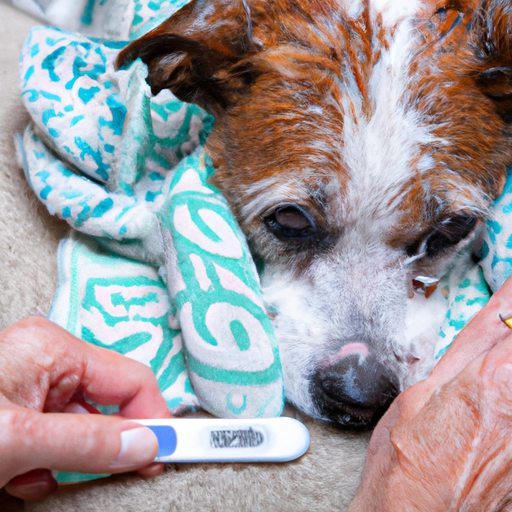Just like humans, our four-legged friends can also fall sick. Fever is one of the most common ailments that dogs can suffer from. A dog’s normal temperature is between 101 and 102.5 degrees Fahrenheit. If it exceeds this range, your pet might be having a fever. While a fever can sometimes be beneficial in fighting off infection, if it gets too high, it can be dangerous. It’s crucial to know how to reduce a dog’s fever safely at home.
Let’s delve into this guide to understand the causes, symptoms, and effective ways of reducing your dog’s fever.
Table of Contents
- Understanding Dog Fever
- Symptoms of Dog Fever
- When to See a Vet
- How to Reduce a Dog’s Fever at Home
- Frequently Asked Questions
Key Takeaways
- Fever in dogs can be caused by several factors, including infection, inflammation, or exposure to toxins.
- Symptoms of dog fever can range from lethargy and loss of appetite to vomiting and shaking.
- It’s essential to consult a vet if your dog’s temperature exceeds 103 degrees Fahrenheit or if the fever lasts more than a day.
- Simple home remedies can help reduce a dog’s fever, but they should never replace professional medical advice.
Understanding Dog Fever
A fever is a natural response of your dog’s body to fight off disease. It can be triggered by various factors such as infection, inflammation, or exposure to toxins. Your pooch may also develop a fever after vaccination as its immune system responds to the vaccine.
Just like humans, dogs have a thermoregulatory system that keeps their body temperature within a safe range. However, when this system is disrupted, it can lead to fever. To accurately detect a fever, you may need a dog thermometer.
Symptoms of Dog Fever
Detecting a fever in dogs can be tricky. Unlike humans, dogs can’t verbally express their discomfort. Therefore, as a caregiver, you need to be observant and look out for signs such as:
- Lethargy
- Loss of appetite
- Vomiting
- Shivering
- Red eyes
- Warm ears
- Coughing
- Nasal discharge
If you notice these signs in your dog, it’s advisable to check their temperature. However, always remember that each dog is unique, and they may show different symptoms.
When to See a Vet
While a mild fever can be managed at home, it’s critical to know when to seek professional help. If your dog’s temperature exceeds 103 degrees Fahrenheit or the fever lasts more than a day, it’s time to consult a vet.
Prolonged fever may be a sign of a more serious condition such as pyometra or parvovirus, which require immediate medical attention.
How to Reduce a Dog’s Fever at Home
While professional help is irreplaceable, there are a few things you can do at home to comfort your furry friend and reduce their fever.
-
Keep Them Hydrated: Just like in humans, fever can cause dehydration in dogs. Ensure your pet has access to fresh and clean water at all times. If they refuse to drink, try enticing them with a low-sodium chicken broth.
-
Use a Cool Cloth: Wet a cloth with cool water and apply it to your dog’s paw pads and ears. This can help reduce their body temperature.
-
Provide a Cool Environment: If your dog is overheating, provide them with a cool and comfortable environment. Turn on the fan or air conditioner and let them rest.
-
Offer Light Meals: Your dog may lose its appetite during fever. However, it’s essential to provide them with light and easily digestible meals like boiled chicken or rice.
-
Avoid Self-Medication: Never give human fever medicine to your dog. Some medications like ibuprofen or acetaminophen can be toxic to dogs. Always consult a vet before administering any medication.
Remember, these tips should not replace a vet’s advice. Always consult a professional if your dog’s condition worsens.
Frequently Asked Questions
Q: Can I use a human thermometer on my dog?
A: While it’s possible to use a human thermometer, a dog thermometer is more accurate and safer.
Q: Can I give human fever medication to my dog?
A: No, never give human fever medication to your dog without consulting a vet. Some human medications can be toxic to dogs.
Q: How can I prevent my dog from getting a fever?
A: Regular vaccination, a balanced diet, and a clean environment can help prevent fever. Also, avoid exposing your dog to harmful toxins and get regular check-ups.
Caring for a sick pet can be challenging, but with the right knowledge and guidance, you can ensure your furry friend gets back on its paws in no time. For more pet care tips, visit One Top Dog.



